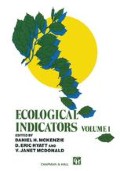Abstract
In this paper, an indicator is defined as some feature of a system that reveals its condition or state. This implies that there is a normal state or multiple states of the system. The presence or absence of an indicator or change in the value of an indicator discloses that the system has deviated from its normal state or that it has changed states, if it has multiple states. For an indicator to be useful, it must be responsive, easy to detect, and specific. An indicator that points to the reason that a system has deviated from its normal state or is in its current state is more useful than a more general indicator that reveals little or nothing about the system other than it has changed.
Prepared for the International Symposium on Biological Indicators, October 15–19, 1990, Ft. Lauderdale, FL.
Access this chapter
Tax calculation will be finalised at checkout
Purchases are for personal use only
Preview
Unable to display preview. Download preview PDF.
References
Bukata, R. P., J. E. Bruton, J. J. Jerome and W. S. Harris. (1988). An evaluation of the impact of persistent water level changes on the areal extent of Georgian Bay/North Channel marshlands. Environmental Management, 12, 359–368.
Kantrud, H. A., J. B. Millar and A. G. van der Valk. (1989). Vegetation of wetlands of the prairie pothole region. In Northern prairie wetlands, ed. A. G. van der Valk, 132–187. Ames, IA, Iowa State University Press.
Millar, J. B. (1973). Vegetation changes in shallow marsh wetlands under improving moisture regime. Canadian Journal of Botany, 51, 1443–1457.
Murkin, H. R., B. D. J. Batt, C. B. Davis, J. A. Kadlec and A. G. van der Valk. (1985). Perspectives on the Delta Waterfowl Research Station—Ducks Unlimited Canada marsh ecology research program. Transactions of the North American Wildlife and Natural Resources Conference, 49, 253–261.
Squires, L. (1991). The water-depth tolerances of emergent plant species in the Delta Marsh, Manitoba. M.S. thesis, Iowa State University, Ames, IA.
van der Valk, A. G. (1981). Succession in wetlands: a Gleasonian approach. Ecology, 62, 688–696.
van der Valk, A. G. (1986). The impact of litter and annual plants on recruitment from the seed bank of a lacustrine wetland. Aquatic Botany, 24, 13–26.
van der Valk, A. G. (1990). Response of wetland vegetation to a change in water level. Paper presented at the International Workshop on Wetland Management and Restoration, Falköping, Sweden, 12–15 September.
van der Valk, A. G. and Davis, C. B. (1980). The impact of a natural drawdown on the growth of four emergent species in a prairie glacial marsh. Aquatic Botany, 9, 301–322.
van der Valk, A. G. and Welling, C. H. (1988). The development of zonation in freshwater wetlands: an experimental approach. In Diversity and pattern in plant communities, ed. H. J. During, M. J. A. Werger and J. H. Willems, 145–158. The Hague, SPB Academic Publishing.
van der Valk, A. G., C. H. Welling and R. L. Pederson. (1989). Vegetation change in a freshwater wetland: a test of a priori predictions. In Freshwater wetlands and wildlife, ed. R. R. Sharitz and J. W. Gibbons, 207–217. Oak Ridge, TN, USDOE Office of Scientific and Technical Information.
Wallsten, M. and P.-O. Forsgren. (1989). The effects of increased water level on aquatic macrophytes. Journal of Aquatic Plant Management, 27, 32–37.
Weller, M. W. and L. H. Fredrickson. (1974). Avian ecology of a managed glacial marsh. Living Bird, 12, 269–291.
Weller, M. W. and C. S. Spatcher. (1965). Role of habitat in the distribution and abundance of marsh birds. Special Report No. 43, Iowa State University Agriculture and Home Economics Experiment Station, Ames, IA.
Welling, C. H., R. L. Pederson and A. G. van der Valk. (1988a). Recruitment from the seed bank and the development of zonation of emergent vegetation during a drawdown in a prairie wetland. Journal of Ecology, 76, 483–496.
Welling, C. H., R. L. Pederson and A. G. van der Valk. (1988b). Temporal patterns in recruitment from the seed bank during drawdowns in a prairie wetland. Journal of Applied Ecology, 25, 999–1007.
Author information
Authors and Affiliations
Editor information
Editors and Affiliations
Rights and permissions
Copyright information
© 1992 Springer Science+Business Media Dordrecht
About this chapter
Cite this chapter
van der Valk, A.G., Squires, L. (1992). Indicators of Flooding Derived from Aerial Photography in Northern Prairie Wetlands. In: McKenzie, D.H., Hyatt, D.E., McDonald, V.J. (eds) Ecological Indicators. Springer, Boston, MA. https://doi.org/10.1007/978-1-4615-4659-7_33
Download citation
DOI: https://doi.org/10.1007/978-1-4615-4659-7_33
Publisher Name: Springer, Boston, MA
Print ISBN: 978-1-4613-7108-3
Online ISBN: 978-1-4615-4659-7
eBook Packages: Springer Book Archive

